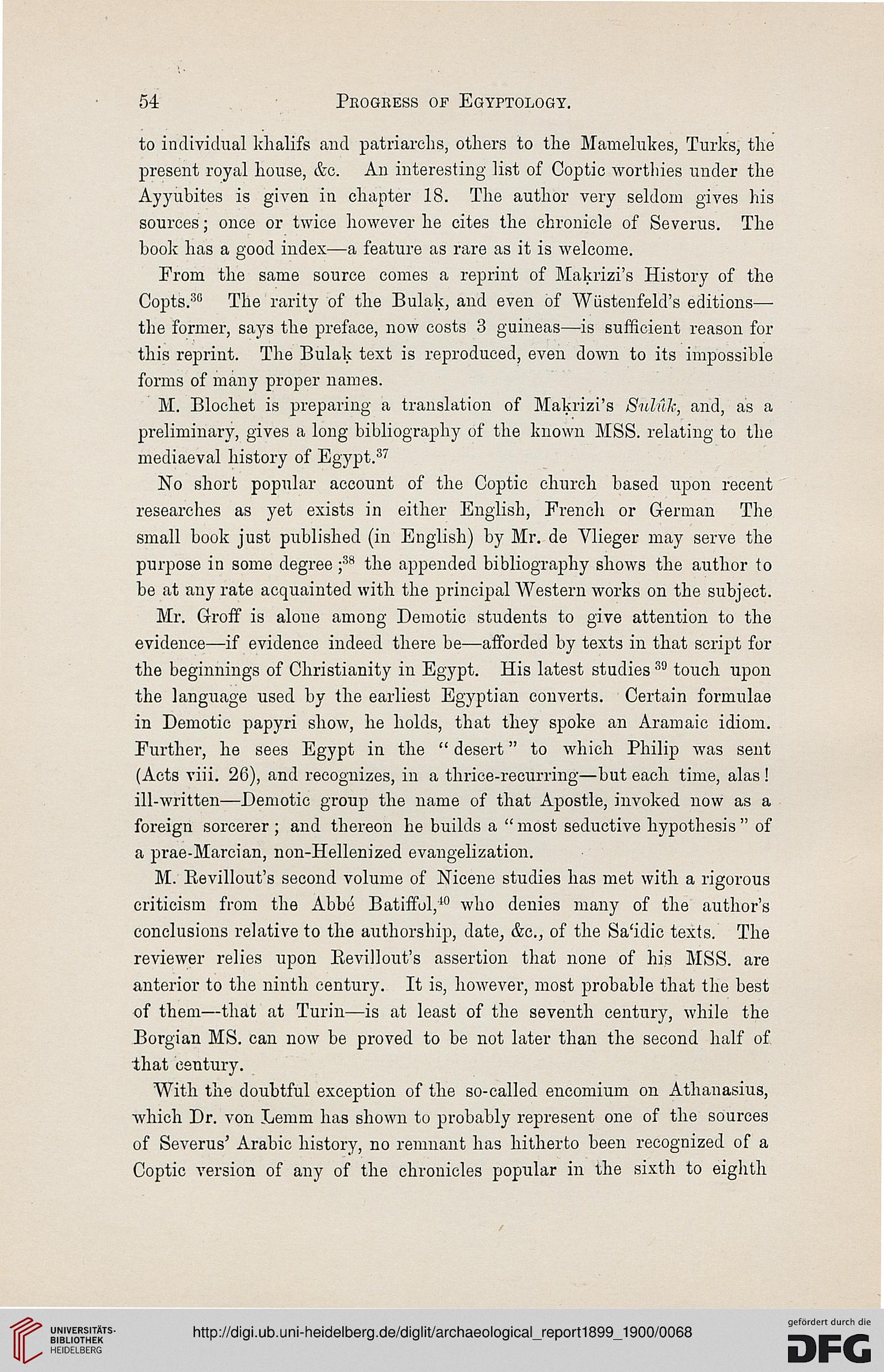54
Peogress of Egyptology.
to individual khalifs and patriarchs, others to the Mamelukes, Turks, the
present royal house, &c. An interesting list of Coptic worthies under the
Ayyubites is given iu chapter 18. The author very seldom gives his
sources; once or twice however he cites the chronicle of Severus. The
book has a good index—a feature as rare as it is welcome.
From the same source comes a reprint of Makrizi's History of the
Copts.30 The rarity of the Bulak, and even of Wustenfeld's editions—
the former, says the preface, now costs 3 guineas—is sufficient reason for
this reprint. The Bulak text is reproduced, even down to its impossible
forms of many proper names.
M. Blochet is preparing a translation of Makrizi's Suluk, and, as a
preliminary, gives a long bibliography of the known MSS. relating to the
mediaeval history of Egypt.37
No short popular account of the Coptic church based upon recent
researches as yet exists in either English, French or German The
small book just published (in English) by Mr. de Vlieger may serve the
purpose in some degree ;sa the appended bibliography shows the author to
be at any rate acquainted with the principal Western works on the subject.
Mr. Groff is alone among Demotic students to give attention to the
evidence—if evidence indeed there be—atfbrded by texts in that script for
the beginnings of Christianity in Egypt. His latest studies3S touch upon
the language used by the earliest Egyptian converts. Certain formulae
in Demotic papyri show, he holds, that they spoke an Aramaic idiom.
Further, he sees Egypt in the " desert" to which Philip was sent
(Acts viii. 26), and recognizes, in a thrice-recurring—but each time, alas!
ill-written—Demotic group the name of that Apostle, invoked now as a
foreign sorcerer; and thereon he builds a " most seductive hypothesis " of
a prae-Marcian, non-Hellenized evangelization.
M. Kevillout's second volume of Nicene studies has met with a rigorous
criticism from the Abbe Batiffol,10 who denies many of the author's
conclusions relative to the authorship, date, &c, of the Sa'idic texts. The
reviewer relies upon Kevillout's assertion that none of his MSS. are
anterior to the ninth century. It is, however, most probable that the best
of them—that at Turin—is at least of the seventh century, while the
Borgian MS. can now be proved to be not later than the second half of
that century.
With the doubtful exception of the so-called encomium on Athanasius,
which Dr. von Lemm has shown to probably represent one of the sources
of Severus' Arabic history, no remnant has hitherto been recognized of a
Coptic version of any of the chronicles popular in the sixth to eighth
Peogress of Egyptology.
to individual khalifs and patriarchs, others to the Mamelukes, Turks, the
present royal house, &c. An interesting list of Coptic worthies under the
Ayyubites is given iu chapter 18. The author very seldom gives his
sources; once or twice however he cites the chronicle of Severus. The
book has a good index—a feature as rare as it is welcome.
From the same source comes a reprint of Makrizi's History of the
Copts.30 The rarity of the Bulak, and even of Wustenfeld's editions—
the former, says the preface, now costs 3 guineas—is sufficient reason for
this reprint. The Bulak text is reproduced, even down to its impossible
forms of many proper names.
M. Blochet is preparing a translation of Makrizi's Suluk, and, as a
preliminary, gives a long bibliography of the known MSS. relating to the
mediaeval history of Egypt.37
No short popular account of the Coptic church based upon recent
researches as yet exists in either English, French or German The
small book just published (in English) by Mr. de Vlieger may serve the
purpose in some degree ;sa the appended bibliography shows the author to
be at any rate acquainted with the principal Western works on the subject.
Mr. Groff is alone among Demotic students to give attention to the
evidence—if evidence indeed there be—atfbrded by texts in that script for
the beginnings of Christianity in Egypt. His latest studies3S touch upon
the language used by the earliest Egyptian converts. Certain formulae
in Demotic papyri show, he holds, that they spoke an Aramaic idiom.
Further, he sees Egypt in the " desert" to which Philip was sent
(Acts viii. 26), and recognizes, in a thrice-recurring—but each time, alas!
ill-written—Demotic group the name of that Apostle, invoked now as a
foreign sorcerer; and thereon he builds a " most seductive hypothesis " of
a prae-Marcian, non-Hellenized evangelization.
M. Kevillout's second volume of Nicene studies has met with a rigorous
criticism from the Abbe Batiffol,10 who denies many of the author's
conclusions relative to the authorship, date, &c, of the Sa'idic texts. The
reviewer relies upon Kevillout's assertion that none of his MSS. are
anterior to the ninth century. It is, however, most probable that the best
of them—that at Turin—is at least of the seventh century, while the
Borgian MS. can now be proved to be not later than the second half of
that century.
With the doubtful exception of the so-called encomium on Athanasius,
which Dr. von Lemm has shown to probably represent one of the sources
of Severus' Arabic history, no remnant has hitherto been recognized of a
Coptic version of any of the chronicles popular in the sixth to eighth





